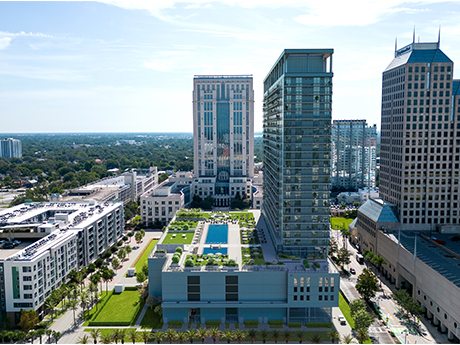Orlando’s multifamily market has experienced softened conditions lately due to a record amount of new supply being built, as well as economic challenges impacting commercial real estate as a whole. Yet, green shoots have emerged as insurance costs continue to ease and interest rates remain steady with downward pressure. Both overall sentiment and renter demand have steadily improved as well.

Properties in the multifamily space seeing the most interest these days are those that are high-quality and well-located. Two key multifamily sale transactions that occurred in the second quarter of 2024 were in the Southwest Orlando submarket. This includes the 424-unit Osprey Links at Hunter’s Creek property that sold for $100.6 million, which marked Orlando’s largest multifamily sale this year, and the 296-unit Sonceto Apartments property that sold for $71 million.
Investors are flooding back into the market with increasingly more aggressive offers and heightened competition as a result of the still limited available multifamily inventory and notion that supply levels have peaked.
However, additional supply will still enter the market in the years to come as developers maintain a positive outlook on Orlando with just over 2,000 units across six buildings delivered by the end of the second quarter thus far, contributing to a 6.1 percent increase from last year. An additional 51 properties totaling over 16,000 units remain under construction, but the pace of construction starts has begun to decelerate, largely attributed to the dramatically increased cost of capital and construction as well as softened fundamentals.

By early 2025, it is expected that absorption rates will outpace new supply as renter demand increases. Vacancy rates across multifamily properties remain elevated with an average of 8 percent but are expected to moderately decline over the next year.
Signs of continued recovery and healthy performance in Orlando’s multifamily sector are already evident. The city experienced the highest quarterly absorption rate seen since the third quarter of 2021 with almost 3,700 units occupied at the end of the second quarter, representing a staggering 127 percent increase compared to the mid-year point one year ago.
While rent growth has remained relatively flat quarter-over-quarter in 2024, record absorption rates along with reduced concessions and continued strong leasing performance should give landlords the momentum needed to start increasing rents later this year. Rents in the second quarter averaged $1,777 per unit but over the next 12 months could grow by as much as 10 percent, according to estimations from CoStar Group.

Landlords of Class A properties are maintaining higher rents, averaging $1,958 per unit as of the end of the second quarter, compared to Class B properties that averaged $1,751 per unit.
The road to recovery for Orlando’s multifamily sector will continue as we enter into the second half of 2024, supported by key market performance trends such as the city’s upward trajectory in population and employment growth. Over 47,000 people moved to Orlando over the past year alone, marking one of the strongest population increases in the state with a 4.1 percent year-over-year increase. Nonfarm employment also grew by 27,500 jobs, which should create a larger renter pool and further necessity for more rental housing.
— By Nick Meoli, vice chairman, Mike Donaldson, vice chairman and Joey Blakley, senior director, Cushman & Wakefield. This article originally appeared in the August 2024 issue of Southeast Real Estate Business.


